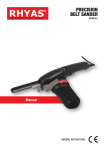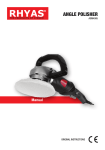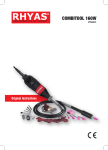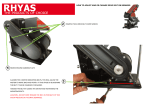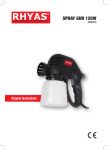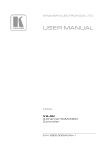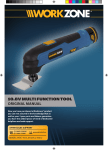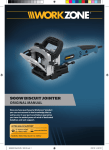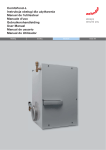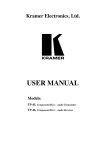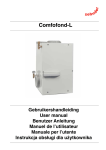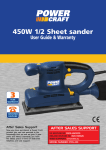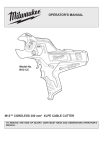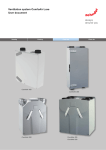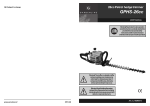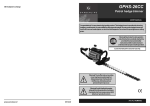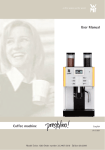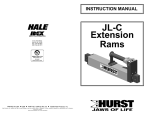Download MULTI TOOL
Transcript
Multi tool OTM4001 Manual ORIGINAL INSTRUCTIONS EN 2 1 6 4 3 A 2 5 EN 5 10 7 8 7 7 11 9 8 12 B 3 EN The product is in accordance with the applicable safety standards in the European directives. MULTITOOL Thank you for buying this Rhyas product. All our products are manufactured to the highest standards of performance and safety. As part of our brand commitment we provide excellent customer service and a 12 month warranty. We hope you will enjoy using this product for many years to come. Safety warnings WARNING Read the enclosed safety warnings, the additional safety warnings and the instructions. Failure to follow the safety warnings and the instructions may result in electric shock, fire and/or serious injury. Keep the safety warnings and the instructions for future reference. The following symbols are used in the user manual or on the product: Read the user manual. Risk of personal injury. Risk of electric shock. Immediately remove the mains plug from the mains if the mains cable becomes damaged and during cleaning and maintenance. Risk of flying objects. Keep bystanders away from the work area. Wear safety goggles. Wear hearing protection. Wear a dust mask. Do not dispose of the product in unsuitable containers. 4 Additional safety warnings for multitools Contact with or inhalation of dust coming free during use (e.g. lead-painted surfaces, wood and metal) can endanger your health and the health of bystanders. Always wear appropriate protective equipment, such as a dust mask. Always use proper dust extraction during use. ● Do not work materials containing asbestos. Asbestos is considered carcinogenic. ● Do not work metal with a magnesium content of more than 80%. ● Be very careful when working painted surfaces. ● Do not use accessories which are not specifically designed and recommended by the manufacturer. Risk of personal injury. ● Inspect the machine and the accessories before each use. Do not use accessories which are bent, cracked, or otherwise damaged. If the machine or one of the accessories is dropped, inspect the machine or the accessory for damage. If necessary, replace the accessory. ● Only use accessories that are recommended by the manufacturer. ● Only use accessories that are suitable for the application. ● Only use accessories with the correct dimensions. ● Do not use accessories that require liquid coolants. Risk of electric shock. ● Make sure that the accessories are properly mounted. Do not use adapters or other aids to mount accessories with another spindle diameter. ● Make sure that the maximum speed for the accessory is larger than or the same as the maximum speed of the machine. Refer to the rating plate on the machine. ● Let the machine run at no load in a safe area after mounting the accessories. If the machine vibrates strongly, immediately switch off the machine, remove the mains plug from the mains, and try to solve the problem. ● Make sure that the workpiece is properly supported or fixed. ● Wear safety goggles. Wear hearing protection. ● ● ● ● ● ● ● ● Wear a dust mask. If necessary, use other protective means, such as safety gloves, safety shoes, etc. Risk of personal injury. Keep bystanders away from the work area. Make sure that all persons in the work area wear protective equipment. Risk of personal injury. Keep the mains cable away from the rotating accessory. If the mains cable touches the rotating accessory, your hands or arms may come in contact with the accessory. Risk of personal injury. Hold the machine by the insulated gripping surfaces where the accessory may contact hidden wiring or the mains cable. If the accessory contacts a ‘live’ wire, the exposed metal parts of the machine can also become ‘live’. Risk of electric shock. Do not use the machine while carrying it at your side. Risk of personal injury. Do not use the machine near flammable materials. Risk of fire. Beware that the accessory continues to rotate for a short period after switching off the machine. Do not attempt to bring the accessory to a standstill yourself. Never put the machine down on a table or a workbench before it has been switched off. Regularly clean the ventilation slots. Risk of electric shock. Electrical safety Always check that the voltage of the power supply corresponds to the voltage on the rating plate. ● Do not use the machine if the mains cable or the mains plug is damaged. ● Only use extension cables that are suitable for the power rating of the machine with a minimum thickness of 1.5 mm2. If you use a extension cable reel, always fully unroll the cable. Mains plug replacement (UK only) If the moulded 3-pin plug attached to the unit is damaged and needs replacing, it is important that it is correctly destroyed and replaced by an approved BS 1363/3A fused plug and that the following wiring instructions are followed. The wires in the mains cable are coloured in EN accordance with the following code: blueneutral brownlive As the colours of the wires in the mains cable of the unit may not correspond to the coloured markings identifying the terminals in the plug, proceed as follows: - The wire which is coloured blue must be connected to the terminal which is marked with the letter N or coloured black. - The wire which is coloured brown must be connected to the terminal which is marked with the letter L or coloured red. TECHNICAL DATA OTM1004 Mains voltage Mains frequency Power input No-load speed Weight V~ Hz W min-1 kg 230 50 280 11,000 - 20,000 1.3 NOISE AND VIBRATION OTM1004 Sound pressure (Lpa) Acoustic power (Lwa) Uncertainty (K) Vibration (sanding on wood) Vibration (sawing in wood) Vibration (scraping in wood) Vibration (sawing in steel) Uncertainty (K) dB(A) 85 dB(A) 96 dB(A) 3 m/s24.2 m/s27.3 m/s28.1 m/s2 5.6 m/s21.5 Wear hearing protection. Vibration level The vibration emission level stated in this instruction manual has been measured in accordance with a standardised test given in EN 60745; it may be used to compare one tool with another and as a preliminary assessment of exposure to vibration when using the tool for the applications mentioned - using the tool for different applications, or with different or poorly maintainted accessories, may significantly increase the exposure level - the times when the tool is switched off or when 5 EN it is running but not actually doing the job, may significantly reduce the exposure level Protect yourself against the effects of vibration by maintaining the tool and its accessories, keeping your hands warm, and organizing your work patterns DESCRIPTION (fig. A) Your multitool has been designed for light sanding, sawing and scraping applications. 1. On/off switch 2. Speed adjustment wheel 3. Mounting point for accessories 4.Grip 5. Allen key 6. Allen key holder ASSEMBLY Before assembly, always switch off the machine and remove the mains plug from the mains. Mounting and removing the sanding pad and the sanding paper (fig. B) The sanding pad and the sanding paper must be used for sanding applications. Mounting ● Place the machine on a table with the mounting point (3) facing upwards. ● Loosen the Allen screw (7) using the Allen key (5). ● Mount the sanding pad (9) to the mounting point (3). ● Tighten the Allen screw (7) using the Allen key (5). ● Mount sanding paper (10) with the required grain size onto the sanding pad (9). Make sure that the perforation in the sanding paper (10) corresponds with the perforation on the sanding pad (9). - Use coarse sanding paper (grain 50) for sanding rough, uneven surfaces. - Use medium sanding paper (grain 80) for removing the remaining scratches from the coarse sanding paper. - Use fine sanding paper (grain 120) for finishing surfaces. Removing 6 ● Place the machine on a table with the mounting point (3) facing upwards. ● Remove the sanding paper (10) from the sanding pad (9). ● Loosen the Allen screw (7) using the Allen key (5). ● Remove the sanding pad (9) from the mounting point (3). ● Tighten the Allen screw (7) using the Allen key (5). Mounting and removing the saw blade (fig. B) The saw blade must be used for sawing applications. Mounting ● Place the machine on a table with the mounting point (3) facing upwards. ● Loosen the Allen screw (7) using the Allen key (5). ● Remove the spacer (8). ● Mount the saw blade (11) to the mounting point (3). ● Mount the spacer (8). ● Tighten the Allen screw (7) using the Allen key (5). Removing ● Place the machine on a table with the mounting point (3) facing upwards. ● Loosen the Allen screw (7) using the Allen key (5). ● Remove the spacer (8). ● Remove the saw blade (11) from the mounting point (3). ● Mount the spacer (8). ● Tighten the Allen screw (7) using the Allen key (5). Mounting and removing the scraping knife (fig. B) The scraping knife must be used for scraping applications. Mounting ● Place the machine on a table with the mounting point (3) facing upwards. ● Loosen the Allen screw (7) using the Allen key (5). ● Remove the spacer (8). ● Mount the scraping knife (12) to the mounting point (3). ● Mount the spacer (8). ● Tighten the Allen screw (7) using the Allen key (5). Removing ● Place the machine on a table with the mounting point (3) facing upwards. ● Loosen the Allen screw (7) using the Allen key (5). ● Remove the spacer (8). ● Remove the scraping knife (12) from the mounting point (3). ● Mount the spacer (8). ● Tighten the Allen screw (7) using the Allen key (5). USE Switching on and off (fig. A) ● To switch on the machine, slide the on/off switch (1) to the front. ● To switch off the machine, slide the on/off switch (1) to the rear. Setting the speed (fig. A) The speed adjustment wheel is used for setting the speed. The speed adjustment wheel can be set to 6 positions. The ideal speed depends on the application and on the material to be worked. Do not set the speed during use. ● Turn the speed adjustment wheel (2) to the required position. Hints for optimum use ● Clamp the workpiece. Use a clamping device for small workpieces. ● Draw a line to define the direction in which to guide the accessory. ● Firmly hold the machine by the grip. ● Switch on the machine. ● Wait until the machine has reached full speed. ● Place the accessory on the workpiece. ● Slowly move the machine along the pre-drawn line, firmly pressing the accessory against the workpiece. ● Do not apply too much pressure on the machine. Let the machine do the work. ● Switch off the machine and wait for the machine to come to a complete standstill before putting the machine down. EN CLEANING AND MAINTENANCE Before cleaning and maintenance, always switch off the machine and remove the mains plug from the mains. ● Regularly clean the housing with a soft cloth. ● Keep the ventilation slots free from dust and dirt. If necessary, use a soft, moist cloth to remove dust and dirt from the ventilation slots. Replacing the accessories (fig. B) Worn or damaged accessories must be replaced immediately. Only use sharp and undamaged accessories. ● To remove the accessory, proceed as described in the corresponding section. ● To mount the accessory, proceed as described in the corresponding section. Warranty Consult the enclosed warranty terms. Environment Disposal The product, the accessories, and the packaging must be sorted for environmentally friendly recycling. Only for EC countries Do not dispose of power tools into domestic waste. According to the European Guideline 2002/96/EC for Waste Electrical and Electronic Equipment and its implementation into national right, power tools that are no longer usable must be collected separately and disposed of in an environmentally friendly way. The product and the user manual are subject to change. Specifications can be changed without further notice. 7 EN General Safety INSTRUCTIONS Warning! Read all instructions. Failure to follow all instructions listed below may result in electric shock, fire and/or serious injury. The term “power tool” in all of the warnings listed below refers to your mains operated (corded) power tool or battery operated (cordless) power tool. Save these instructions. 1) Work area a.Keep work area clean and well lit. Cluttered and dark areas invite accidents. b.Do not operate power tools in explosive atmospheres, such as in the presence of flammable liquids, gasses or dust. Power tools create sparks which may ignite the dust of fumes. c.Keep children and bystanders away while operating a power tool. Distractions can cause you to lose control. 2)Electrical safety a.Power tool plugs must match the outlet. Never modify the plug in any way. Do not use any adapter plugs which earthed (grounded) power tools. Unmodified plugs and matching outlets will reduce risk of electric shock. b.Avoid body contact with earthed or grounded surfaces such as pipes, radiators, ranges and refrigerators. There is an increased risk of electric shock if your body is earthed or grounded. c.Do not expose power tools to rain or wet conditions. Water entering a power tool will increase the risk of electric shock. d.Do not abuse the cord. Never use the cord for carrying, pulling or unplugging the power tool. Keep cord away from heat, oil, sharp edges or moving parts. Damaged or entangled cords increase the risk of electric shock. e.When operating a power tool outdoors, use an extension cord suitable for outdoor use. Use of a cord suitable for outdoor use reduces the risk of electric shock. Always use tool in conjunction with a residual circuit breaker device. 3) Personal safety a.Stay alert, watch what you are doing and use common 8 sense when operating a power tool. Do not use a power tool while you are tired or under the influence of drugs, alcohol or medication. A moment of inattention while operating power tools may result in serious personal injury. b.Use safety equipment. Always wear eye protection. Safety equipment such as dust mask, non-skid safety shoes, hard hat, or hearing protection used for appropriate conditions will reduce personal injuries. c.Avoid accidental starting. Ensure the switch is in the off position before plugging in. Carrying power tools with your finger on the switch or plugging in power tools that have the switch on invites accidents. d.Remove any adjusting key or wrench before turning the power tool on. A wrench or a key left attached to a rotating part of the power tool may result in personal injury. e.Do not overreach. Keep proper footing and balance at all times. This enables better control of the power tool in unexpected situations. f.Dress properly. Do not wear loose clothing or jewellery. Keep your hair, clothing and gloves away from moving parts. Loose clothes, jewellery or long hair can be caught in moving parts. g.If devices are provided for the connection of dust extraction and collection facilities, ensure these are connected and properly used. Use of these devices can reduce dust related hazards. h.Use clamps or a vice to hold work. It’s safer than using your hand and it frees both hands to operate tool. 4) Power tool use and care a.Do not force the power tool. Use the correct power tool for your application. The correct power tool will do the job better and safer at the rate for which it was designed. b.Do not use the power tool if the switch does not turn it on and off. Any power tool that cannot be controlled with the switch is dangerous and must be repaired. c.Disconnect the plug from the power source before EN making any adjustments, changing accessories, or storing power tools. Such preventive safety measures reduce the risk of starting the power tool accidentally. d.Store idle power tools out of the reach of children and do not allow persons unfamiliar with the power tool or these instructions to operate the power tool. Power tools are dangerous in the hands of untrained users. e.Maintain power tools. Check for misalignment or binding of moving parts, breakage of parts and any other condition that may affect the power tools operation. If damaged, have the power tool repaired before use. Many accidents are caused by poorly maintained power tools. f.Keep cutting tools sharp and clean. Properly maintained cutting tools with sharp cutting edges are less likely to bind and are easier to control. g.Use the power tool, accessories and tool bits etc., in accordance with these instructions and in the manner intended for the particular type of power tool, taking into account the working conditions and the work to be performed. Use of the power tool for operations different from intended could result in hazardous situation. h.Damaged switches must be replaced at a customer service repair centre. Do not use power tools that cannot be switched on and off. i.Do not leave power tools unattended while they are switched on. Always switch off the tool and wait until it has come to a full standstill before leaving. j.If the mains cable has been damaged, it must be replaced with a special mains cable. These can be obtained from the manufacturer or the manufacturer’s customer service department. The mains cable may only be replaced by the manufacturer, the manufacturer’s customer service department or equally qualified persons. another battery pack. c.Use power tools only with specifically designated battery packs. Use of any other battery packs may create a risk of injury and fire. d.When battery pack is not in use, keep it away from other metal objects like paper clips, coins, keys, nails, screws, or other small metal objects that can make a connection from one terminal to another. Shorting the battery terminals together may cause burns of a fire. e.Under abusive conditions, liquid may be ejected from the battery; avoid contact. If contact accidentally occurs, flush with water. If liquid contacts eyes, additionally seek medical help. Liquid ejected from the battery may cause irritations or burns. 6)Service a.Please use a qualified expert who uses original replacement parts to repair your power tool. This will ensure proper functioning of the power tool. b.Caution! The use of any accessories or additional tools other than those recommended in this manual may lead to an increased risk of injury. Only use original replacement parts. 5) Battery tool use and care a.Ensure the switch is in the off position before inserting battery pack. Inserting the battery pack into power tools that have the switch on invites accidents. b.Recharge only with the charger specified by the manufacturer. A charger that is suitable for one type of battery pack may create a risk of fire when used with 9 EN Exploded view Spare parts list No.Description 706109 Spindle bushing 706110 Bearing 6001-2RS 706111 Spindle 706112 Ring+ screw 706113 Bearing 625 706114 Bearing 608-2Z 706115 Rotor 706116 Carbon brush assy. +holder set 706117 Bearing 607-2Z 706118 Stator 706119 Switch lever 706120 PCB 10 Position 13, 14 15 18 19, 20 8 11 31 24, 25 32 33 22 28 EN DECLARATION OF CONFORMITY OTM4001 - multi tool (EN)We declare under our sole responsibility that this product is in conformity with directive 2011/65/EU of the European parliament and of the council of 9 June on the restriction of the use of certain hazardous substances in electrical and electronic equipment is in conformity and accordance with the following standards and regulations: EN 55014-1, EN 55014-2, EN 60745-1, EN 60745-2-4, EN 61000-3-2, EN 61000-3-3 2006/42/EC, 2006/95/EC, 2004/108/EC, 2002/96/EC, 2011/65/EU Zwolle, 01-05-2014 W. Dekens CEO Mactool Industrial BV It is our policy to continuously improve our products and we therefore reserve the right to change the product specification without prior notice. Mactool Industrial BV • Lingenstraat 6 • 8028 PM • Zwolle The Netherlands 11 1406-11












